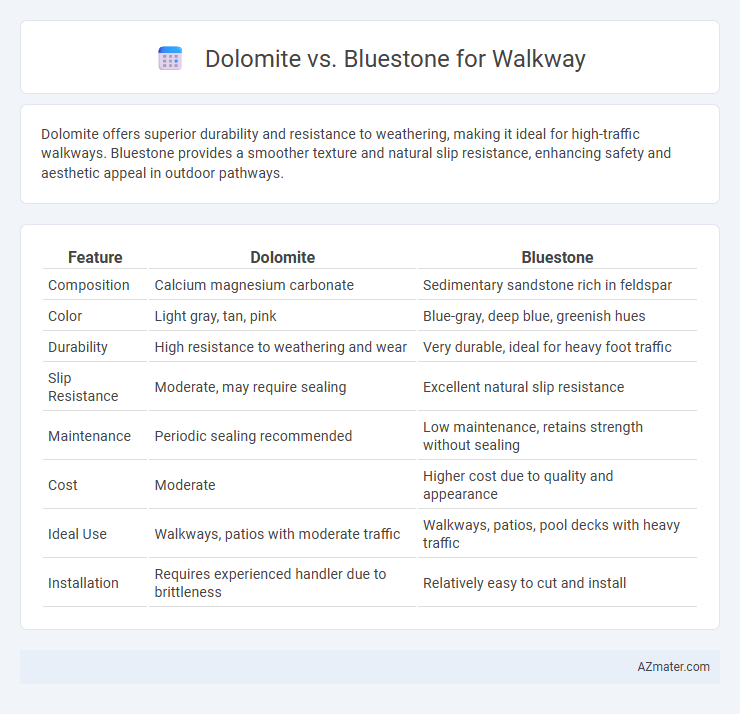Dolomite offers superior durability and resistance to weathering, making it ideal for high-traffic walkways. Bluestone provides a smoother texture and natural slip resistance, enhancing safety and aesthetic appeal in outdoor pathways.
Table of Comparison
| Feature | Dolomite | Bluestone |
|---|---|---|
| Composition | Calcium magnesium carbonate | Sedimentary sandstone rich in feldspar |
| Color | Light gray, tan, pink | Blue-gray, deep blue, greenish hues |
| Durability | High resistance to weathering and wear | Very durable, ideal for heavy foot traffic |
| Slip Resistance | Moderate, may require sealing | Excellent natural slip resistance |
| Maintenance | Periodic sealing recommended | Low maintenance, retains strength without sealing |
| Cost | Moderate | Higher cost due to quality and appearance |
| Ideal Use | Walkways, patios with moderate traffic | Walkways, patios, pool decks with heavy traffic |
| Installation | Requires experienced handler due to brittleness | Relatively easy to cut and install |
Introduction to Walkway Materials
Dolomite and bluestone are popular natural stone choices for walkway construction due to their durability and aesthetic appeal. Dolomite offers a lighter color palette with a smooth texture, making it ideal for modern, bright outdoor spaces, while bluestone features a dense, fine-grained composition with a distinctive blue-gray hue perfect for traditional and rustic designs. Both materials provide slip resistance and weather tolerance, making them suitable for various climates and foot traffic levels.
What is Dolomite?
Dolomite is a sedimentary carbonate rock composed primarily of the mineral dolomite, offering a durable and weather-resistant surface ideal for walkways. Its dense structure provides excellent traction, making it suitable for both residential and commercial pathways. Compared to bluestone, dolomite is generally lighter in color and can offer a smoother finish, enhancing aesthetic appeal while maintaining functionality.
What is Bluestone?
Bluestone is a dense, durable natural stone primarily composed of sandstone or limestone, known for its rich blue-gray hues and slip-resistant surface ideal for walkways. Its fine-grained texture provides excellent strength and weather resistance, making it a popular choice for outdoor pathways that require both aesthetic appeal and functionality. Bluestone's natural cleft finish ensures traction even in wet conditions, enhancing safety for pedestrian use.
Aesthetic Differences: Dolomite vs Bluestone
Dolomite walkways offer a lighter, creamy beige tone with a crystalline texture that reflects sunlight, creating a bright, elegant appearance ideal for modern or Mediterranean-style landscapes. Bluestone features a richer, bluish-gray hue with natural veining and a smooth, matte finish that provides a classic, timeless look suitable for traditional and rustic walkways. The contrasting color palettes and surface textures of Dolomite and Bluestone significantly influence the overall aesthetic impact, catering to different design preferences and outdoor ambiance.
Durability and Longevity Comparison
Dolomite offers exceptional durability for walkways due to its dense texture and resistance to weathering, making it less prone to cracking and chipping over time. Bluestone is similarly durable but tends to be slightly softer, which can lead to minor surface wear and erosion in high-traffic areas. Both materials provide long-lasting solutions, though Dolomite generally outperforms Bluestone in longevity under harsh environmental conditions.
Slip Resistance and Safety
Dolomite offers moderate slip resistance for walkways, making it suitable for areas with light foot traffic but may become slippery when wet. Bluestone is known for its excellent slip resistance due to its natural cleft finish, providing enhanced safety in both dry and wet conditions. Choosing Bluestone for walkways improves traction and reduces the risk of slips and falls, making it a safer option for high-traffic outdoor paths.
Installation and Maintenance
Dolomite walkways require precise leveling and a stable base during installation to prevent shifting due to their density and smooth texture, while bluestone offers easier handling with its naturally flat surfaces, allowing for quicker placement. Maintenance of dolomite involves regular sealing to protect against weathering and staining, whereas bluestone requires less frequent sealing but benefits from periodic cleaning to avoid moss and algae buildup. Both materials demand proper joint filling to enhance durability and reduce weed growth, with bluestone's porosity necessitating slightly higher upkeep compared to the more compact dolomite.
Cost Analysis: Dolomite vs Bluestone
Dolomite generally costs less than bluestone, making it a more budget-friendly option for walkways without compromising durability. Bluestone, known for its premium aesthetic and higher density, often commands a higher price per square foot, reflecting increased longevity and resistance to wear. Homeowners should weigh initial material costs against maintenance and lifespan to determine the best value for their walkway project.
Environmental Impact and Sustainability
Dolomite and bluestone differ significantly in environmental impact and sustainability for walkways. Dolomite extraction typically involves less quarry disruption and has lower carbon emissions due to its abundance and easier milling processes. Bluestone, while durable and attractive, often requires more intensive mining techniques, leading to greater habitat disturbance and higher energy consumption in processing, making dolomite a more sustainable choice for eco-conscious landscaping projects.
Choosing the Right Stone for Your Walkway
Dolomite offers a durable and weather-resistant surface ideal for walkways in regions with fluctuating climates, while bluestone provides a smooth texture and elegant appearance that enhances aesthetic appeal. Consider the hardness, slip resistance, and color variation of each stone; dolomite tends to be more resistant to wear and staining, whereas bluestone offers a wider range of natural hues from blue-gray to green. Evaluate local availability and budget constraints to choose the stone that best balances functionality, maintenance, and design for your walkway project.

Infographic: Dolomite vs Bluestone for Walkway
 azmater.com
azmater.com